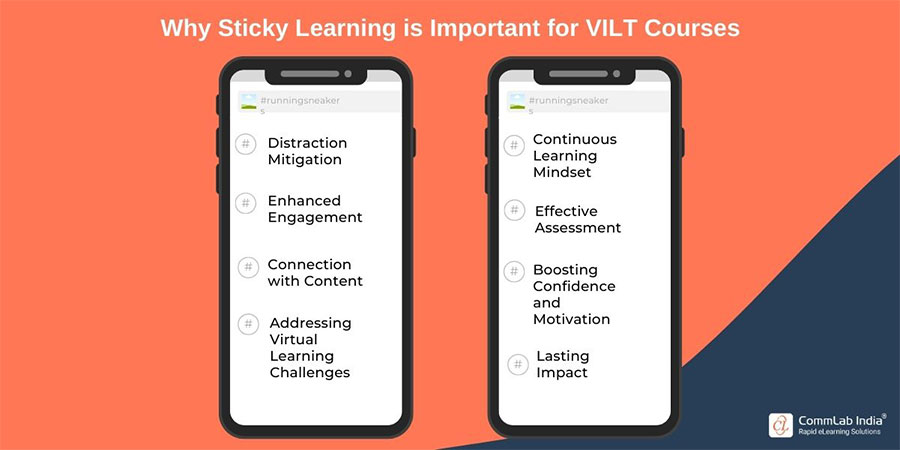The Secrets of Sticky Learning: 10 Vital Factors in VILT Course Design

Have you noticed your employees feeling disconnected and disengaged during virtual training sessions? Do you wish there was a way to make online learning as captivating and memorable as in-person classes? Well, buckle up because we're about to unveil the secrets of sticky learning! In this blog post, we'll explore the 10 vital factors that can transform your VILT (Virtual Instructor-Led Training) course design from mundane to mind-blowing.
Get ready to revolutionize your learning experience and discover how to create an unforgettable journey for both learners and trainers alike.
What is VILT (Virtual Instructor-Led Training)?
VILT, or Virtual Instructor-Led Training, is a powerful training approach that uses technology to bring engaging and interactive learning experiences to participants, connecting them with instructors and peers remotely. It bridges the gap between traditional classroom learning and the evolving needs of the digital age.
VILT breaks down geographical barriers, making education accessible to a global audience.
Here are the features, benefits and challenges associated with VILT:
Why Sticky Learning is Important for VILT Courses
Sticky learning, a term coined to describe long-lasting and impactful learning experiences, is particularly crucial in the context of VILT courses. Unlike traditional face-to-face classes, VILT relies heavily on virtual platforms, which can sometimes lead to disengagement and distractions. Thus, making learning 'sticky' ensures that the knowledge gained during a VILT session is retained, applied, and continuously built upon.
Here's why it matters:

Distraction Mitigation: By captivating attention, sticky learning minimizes the impact of distractions prevalent in virtual environments, fostering a focused learning experience.
Enhanced Engagement: Engaging content and interactive elements heighten employee engagement, making virtual training sessions more enjoyable and memorable.
Connection with Content: Sticky learning forges a meaningful connection between participants and course content, emphasizing relevance and practicality.
Addressing Virtual Learning Challenges: Tailored methodologies counteract challenges unique to VILT, creating an immersive and participatory virtual learning experience.
Continuous Learning Mindset: Sticky learning encourages a mindset of continuous learning, motivating participants to seek additional knowledge and skills beyond formal training.
Effective Assessment: Facilitating effective assessment of learning outcomes, sticky learning helps measure the success of VILT courses and informs future improvements.
Boosting Confidence and Motivation: Successful retention and application of knowledge bolster participants' confidence and motivation to excel in virtual training.
Lasting Impact: Sticky learning ensures the impact of VILT courses extends beyond the virtual classroom, influencing participants' professional endeavors long after the course concludes.
→ Download Now: A Beginner's Guide to VILT [eBook]
Now that you understand the importance of sticky learning in VILT, let us discuss the 10 key factors that you need to keep in mind when developing VILT courses:
The 10 Vital Factors for Sticky Learning in VILT Courses
1. Captivating Content Delivery: To make virtual learning stick, use interesting content like lively presentations, diverse media, and interactive activities. These keep participants focused and engaged during the session.

2. Interactive Platforms and Tools: Boost participation by using virtual tools. Add polls, quizzes, and breakout sessions to keep everyone actively involved, creating a collaborative learning space.
3. Transparent Learning Goals: Ensure participants know what to expect from the virtual session with clear learning objectives. These objectives guide both learners and instructors in shaping the content to achieve specific learning outcomes.
4. Adaptability to Different Learning Styles: Recognizing and catering to diverse learning styles is key in VILT courses. Incorporating a mix of visual, auditory, and kinesthetic elements ensures that the content resonates with a broad spectrum of participants.
5. Real-World Connections: Make learning practical by linking theoretical concepts to real-life situations. VILT courses should highlight how the knowledge gained can be applied in participants' professional lives, adding relevance and value to the learning experience.
6. Regular Checks and Feedback: Keep learning on track with continuous eLearning assessments. Regular quizzes, polls, and feedback sessions help participants understand their progress, pinpoint areas for improvement, and stay actively engaged in the learning process.
7. Customized Learning: Boost engagement and retention by tailoring the learning experience to individual needs. VILT courses should allow participants to personalize their learning paths, focusing on areas that align with their goals and interests.
8. Instructor Presence and Skills: Instructors play a crucial role in VILT success. A strong online presence, effective facilitation skills, and the ability to create a supportive learning environment significantly contribute to the effectiveness of VILT courses.
9. Learning Together: Foster a sense of community and shared learning by encouraging collaboration. Group projects, discussions, and peer-to-peer interactions enhance the learning journey, making it more memorable and impactful.
10. Post-Training Support: Ensure learning extends beyond the virtual classroom by providing post-training resources. Additional readings, recorded sessions, and support forums contribute to knowledge retention and application over time, reinforcing the learning experience.
Wrapping Up
As the corporate training landscape continues to evolve, VILT stands at the forefront of innovative learning methodologies. Its potential to transcend geographical boundaries and deliver tailored, interactive learning experiences is unmatched. However, unlocking the full power of VILT requires a deliberate focus on creating sticky learning environments that captivate participants, align with adult learning principles, and incorporate the vital factors outlined in this blog.
By understanding the dynamics of VILT and embracing the principles and factors discussed, training managers and organizations can maximize the impact of their virtual training programs, empowering learners to not only acquire knowledge but to apply it meaningfully in their professional lives.
Interested in exploring more about VILT? Here's an insightful resource for you:



![Key Leadership Skills to Overcome Business Challenges [Infographic]](https://blog.commlabindia.com/hubfs/blogs/key-leadership-skills-overcome-business-challenges-info.jpg)

